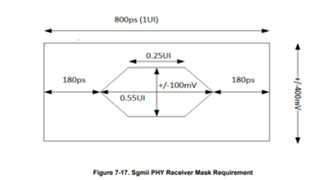Tool/software:

Hello,
I measured an eye width of about 310 ps on the TLK2501 serial receiver pins (see attached file). However the eye has a poor signal quality, really slow rising time.
My questions:
1. The receiver side is specified to have differential jitter tolerance of 0.6UI. Should the attached eye be fine regarding the signal quality?
2. Please give me the serial receiver mask requirement for TLK2501, so it's easier for me to check whether my measurement results according to specification or not.
Thanks in advance.
Regards,
Theresia


